By Rob Feld

The iconic character of Gore Verbinski’s
Pirates of the Caribbean trilogy, Captain Jack Sparrow (Johnny Depp), met his apparent end in the second installment, Dead Man’s Chest. The cliffhanger ending left his impending rescue from an otherworldly banishment up to his comrades and a mystic named Tia Dalma (Naomie Harris), in Verbinski’s final chapter of the saga, At World’s End.
"Jack’s arrival scenes have always been sort of stand-alones," says Verbinski, who finally introduces Jack at the beginning of the second act, living on his boat, the Black Pearl, in a surrealist landscape aesthetically different from the rest of the movie. "He’s in Davy Jones Locker," a singular kind of hell. For Jack, this represents the worst purgatory imaginable: living with himself."
The scene begins with Jack’s nose entering a white frame, sniffing about and finding a single peanut on the Pearl. But before he can eat it, he is shot by his doppelgänger for stealing it. Verbinski then reveals a ship full of such absurdly rendered doppelgängers, under the command of the murderous Jack. After some high jinks, the captain abandons ship to escape it all, leaving him in a salt-flat wasteland with the beached Pearl. He
is unable to move the ship until it is finally lifted up and carried into the distance by an army of crabs disguised as smooth white stones, sent via incantation by Tia Dalma to bring Jack out of the limbo.
Sound out there? Well, there is a method to the madness.
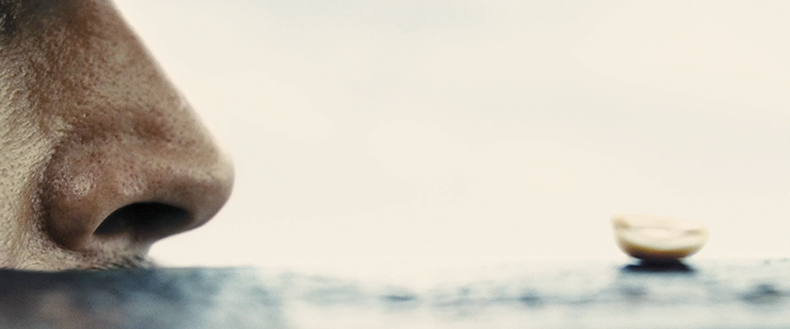
In an intentional departure from the ‘grand announcement’ that had always marked Jack’s arrival, the idea here was to fragment the icon. We start with a nose sniffing around the deck and railing of the Pearl in search of a morsel, then a bit of his signature goatee as he tucks his napkin into his collar, followed by a large plate with a diminutive peanut, as a fork approaches, slowly showing more and more bits of Jack as we build. In this frame, the camera was rigged so that Johnny could push a skateboard dolly with an offset arm pressed against his forehead, thereby ensuring a sort of nasal lock. Securing the frame on the sniffing proboscis makes the body part its own detached being.
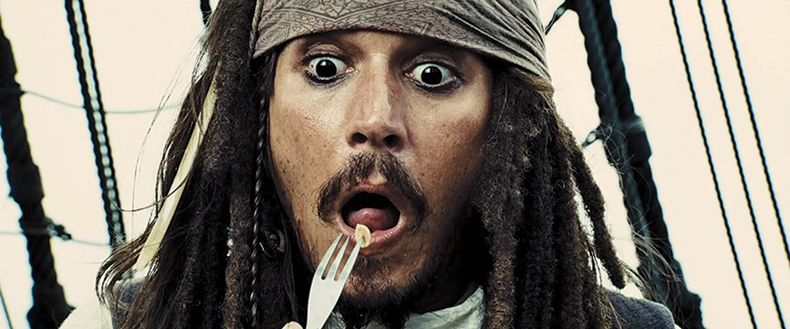
The camera tilts up, following the fork to the anticipating orifice where we briefly reveal the salivating captain, who is instantly shot dead. The sequence celebrates
our appreciation of Keaton and Chaplin, and the shots were designed to allow Johnny to bring his silent-era truth to the modern age. We are both musicians at heart, so we discuss things like character intentions and reactions in musical terms. We’ll talk about the click, cadence, a
drunken waltz; and everything has a beat per minute: ’This sequence should be 120 BPM, this one should be 80,’ so we are both on the same page in terms of the hidden click track of the performance and what the intended cutting pattern will be.
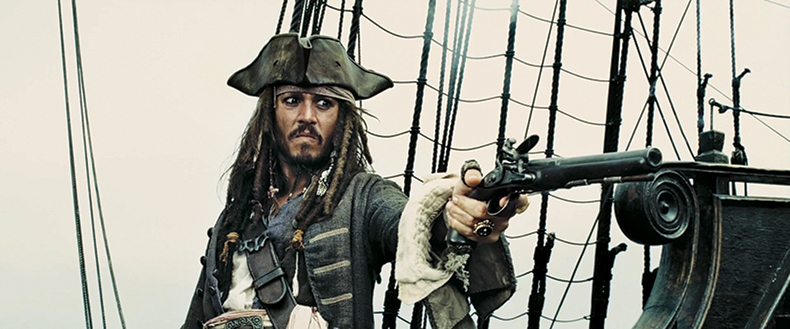
The camera pans to reveal that Jack has been murdered by his doppelgänger. The idea was to start very small over a series of tight shots and unveil the absurdity
of the situation as things widen out. Jack just shot Jack for attempting to steal his peanut, and as he proceeds to yell orders to the crew, more and more Jacks appear. It’s all an escalating madness. I didn’t want to play any of the main themes in the soundtrack—in an identity crisis moment— I wanted Jack to be robbed of his tune. So Hans Zimmer’s music here was based on
the sound effects to create an agitating cacophony, a reflection of a bizarre and cluttered mind.
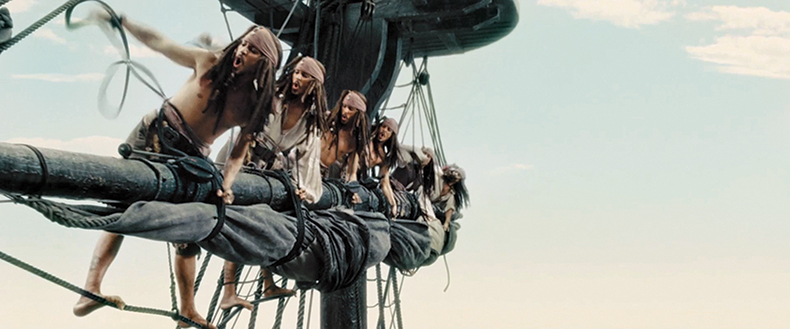
The initial shots were quite simple. Carefully placed wipes were used in the whip pans to put Jack in numerous locations around the ship. I would shoot the scene with doubles and then move Jack around to different places to get different reactions, eventually rotoscoping Johnny in to replace the doubles—or not, if they were out of focus enough. I don’t like to shoot green screen, because you lose so much of the traditional light interactions
[like] Jack’s white shirt while standing next to himself in a dark coat; you lose all the light bounce. This shot was done on stage with a mast set piece in a sort of nod to Busby Berkeley musicals with a Sex Pistols’ "Friggin’ in the Riggin’" energy.
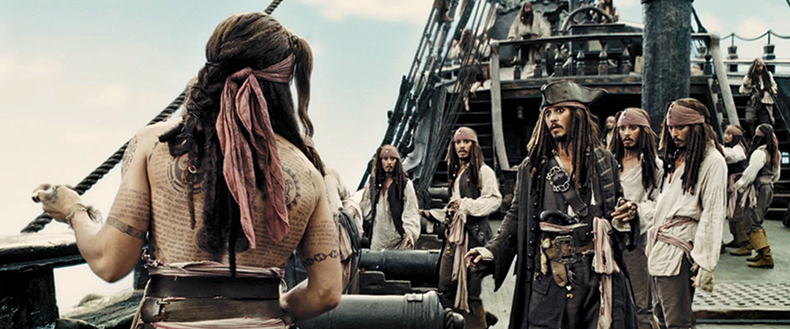
Here Jack berates a version of himself for an untidy ‘tack line’ and ultimately runs him through with his own saber in his escalating, unpleasant delusion. Motion control is a pain, but in situations like these, there really is no substitute. Synchronizing
the performances and reactions while maintaining the ability to naturally move the camera with the blocking takes time, and everyone needs to stay focused. With a repeat camera move, all the perspectives have to be correct. You have occlusion issues, arms start going through other people’s bodies, and things like that. It’s much easier when the camera’s locked off. Fortunately, Johnny is insanely accurate in terms of hitting his mark.
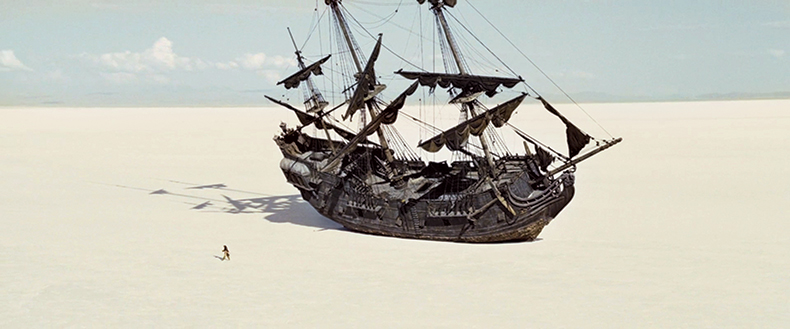
After Jack abandons the vessel, we cut to a helicopter shot and reveal another layer of this odd personal limbo. Jack finally has his beloved Pearl but, in a cruel irony, no ocean on which to sail her. This part of the sequence was shot entirely in one day during preproduction as a sort of scout/shoot day. With only one actor to worry about and no real set, we were able to get it all completed very quickly with a reduced unit at the Bonneville Salt Flats.
It was just a tabletop discussion with a toy boat the night before at the hotel, then a storyboard sketch, then sitting down with [the helicopter guys]. It’s not an action sequence, but it’s nice to see the big perspective of the boat.
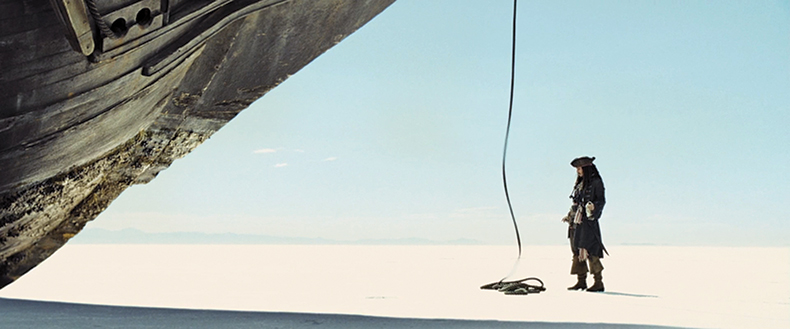
Throughout this section, the Black Pearl was a large, scale miniature, shot in postproduction, ‘match-moved,’ and composited at ILM. On location we had a bit of scaffolding, some duvetyn for negative, and a couple of poles to indicate scale for framing and composition, but not much else. Here we simply dropped the anchor line from a small Condor crane covered in blacks and added in the bow of the ship later. Duplicating the lighting is critical.
When we shoot in sunlight, every additional element must be shot in the sun. I don’t like artificial lighting. Nothing has the feel of the single source: sunlight. So the miniature had to be shot with the sun at the exact same inclination.
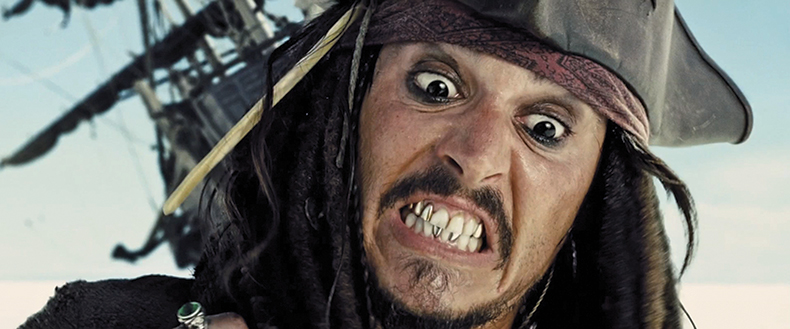
Borrowing from Salvador Dali and Buster Keaton, the images and performance in this sequence are graphic and absurd, using the Utah salt flats as a neutral
environment so you focus on subject, shadow, and the absence of everything. After he discovers the rope, we slam cut to Jack trying to pull the ship by himself. This shot was most likely the 27 mm close focus: a great piece of glass. I bet 80 percent of the shots in the three films were either
on a 27 mm or 40 mm. The 27 mm is very clean on the edges with a lot of extreme perspective. When Jack lunges quickly into frame here, his eyes have to be pin sharp. The performance has an impulse and a striking emphasis.
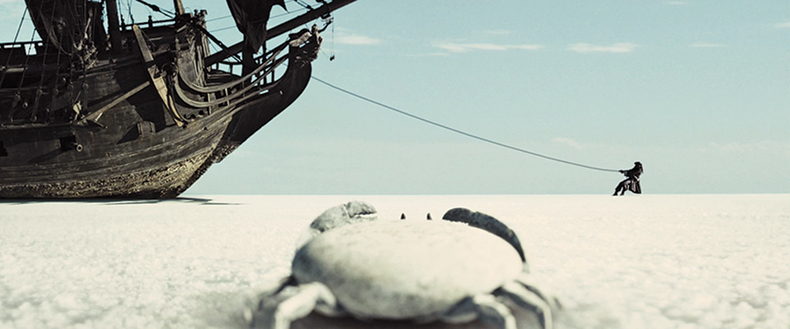
After this rock mysteriously follows Jack, is licked by him and thrown away, the rock transforms into a strange land crab summoned by the mystic Tia Dalma to come to the aid of Jack. Here the frame itself creates a certain anthropomorphic quality: the inanimate observer. By implying the rock/crab is watching, we assume it is taking in the absurdity of the situation. It is loading the next shot, anticipating the reaction. This shot worked just as well with the stand-in stone prop, which was then scanned in and animated by the team at ILM. But the composition is doing most of the heavy lifting here. It’s old-fashioned but effective.
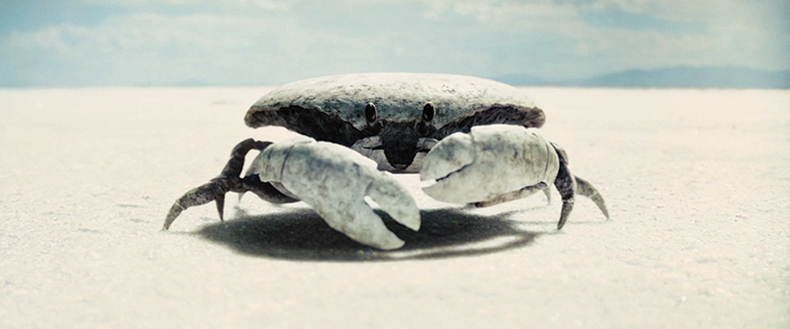
The personality of the lead crab is another voice, an observer we get to observe. I think this crab is confounded by the idiocies it’s witnessing—a kind of Jack Benny, or very minimal like Nick Park’s animation in Wallace & Gromit. How do you make a crab produce a deadpan expression? There were infinite discussions about the eyes and the right amount of pause before one blink. Here, symmetry of the composition becomes a factor. We framed up on the practical rock and then removed it for the plate. I treat animators like actors and we discuss the performance in depth. I was lucky to have Hal Hickel as my key animator. When I work with VFX houses, I ask for people by name. It’s casting.
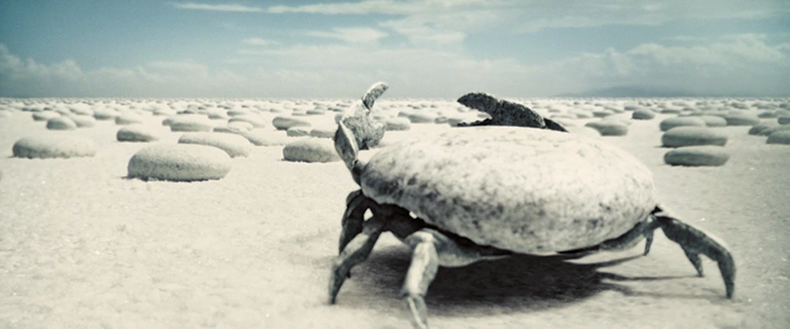
Here we laid out a field of stones and tracked along with the dolly underslung. All of the rocks were hand-painted to match the basic color of the salt. Stones were a
foreign object out there, but I wanted them integrated. We shot 35 mm 50 ASA Kodak Daylight film for this sequence and skip bleached the negative. I remember the scanners had to be recalibrated because
skip bleaching the neg changes the thickness of the emulsion radically. Once we dialed that in, we were able to modify the color curve quite a bit: I wanted the whites to bleach out without the midtones getting too heavy or overly crushed. Surreal, not rad.
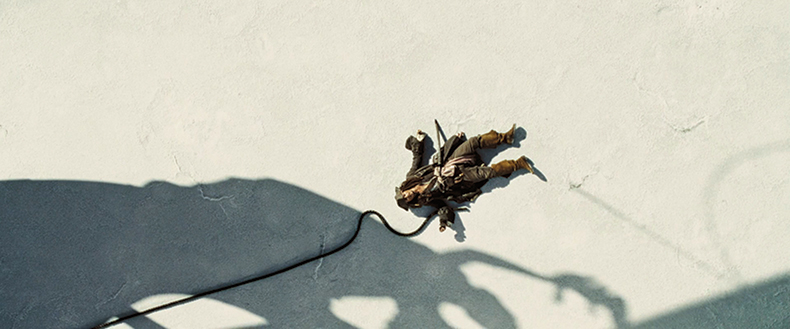
Jack passes out, giving up trying to pull his ship. Then off camera we hear the gurgling of the crabs. Something’s moving. A shadow crosses his face. We cut wide and see the bow of the Pearl moving across his body. We lensed it early in the day, got out the compass to figure the angle of light and what exact time would give us shadows of good length. We were able to get very low-fi in our methods. Here we moved a cardboard cutout on a Condor crane for the shadow effect. In a world of compromise and chaos, with 4 a.m. call times just to get 500 extras put into period clothing, most days on a Pirates film are a massive undertaking. This sequence was a delight
to shoot, and it was dry.
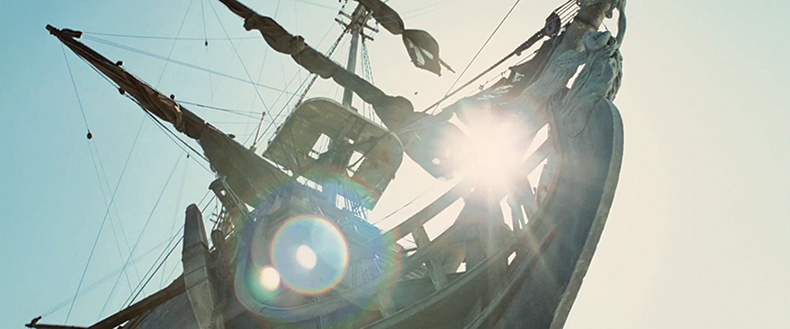
This shot was done later on in the schedule and stolen between setups in the Caribbean. It’s simply a dolly shooting the full-scale Pearl from a dock at base camp. These crabs are picking up the ship and carrying it off with them. The little things like the low rumble of something moving, and then the shadow before you show the actual ship. Then even when you show it, it’s just the very bow of the boat and these crabs tumbling over each other to try and move this thing. Throwing in one shot of the real boat here keeps people guessing. It’s nice to mix it up.
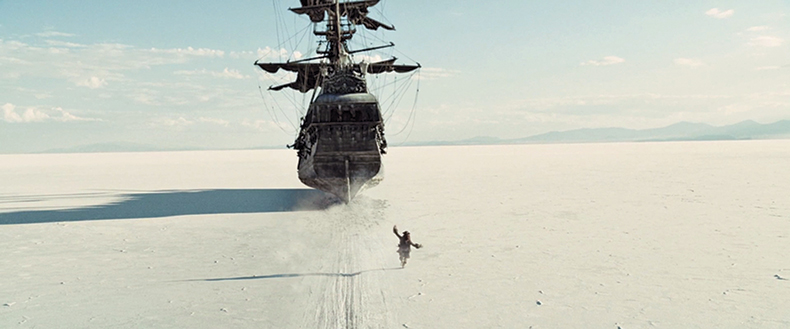
Here, Jack chases his ship, carried off by the crabs as we crane up. I like the uncluttered frame. There is so much you can do with a figure in a landscape: an object
and a subject. This final moment is a crescendo into an abrupt sonic cut, leaving Jack in peril so he can arrive heroically in the next sequence. Then he does finally get his ‘grand announcement’ moment, standing proudly on the Pearl as it crests the dunes, carried by 100,000 crabs. But
primarily this was a deconstruction of the Jack myth. Every franchise is eventually burdened by its own success and everyone wants you to repeat what worked before. So it was rare to be able to so boldly embrace the wondrous and the strange.
See more Shots to Remember